In the previous feature we discussed some motorcycle safety and survival tips regarding the dangers presented by other vehicles…in particular the dangers associated with navigating intersections. We discussed some of the things you can do as the operator of a motorcycle to become more visible to those you’re forced to share the road with. We continue that discussion today with more things you can do to heighten your visibility, and more traps to watch for when you’re pursuing your two-wheeled passion.
Fashion Statements
When talking about motorcycle safety and survival the conversation often turns to a rider’s choice of apparel. It cannot be disputed that high visibility gear helps others see you. The next time you approach a construction site, a working utility crew or an intersection where traffic is being directed by a law enforcement officer; take note of what it is that catches your eye first. That’s right. It’s the hi-visibility safety vests the workers are wearing.
There can be no denying the fact that wearing “hi-viz” colors when you ride makes you more noticeable to those you’re sharing the road with. Studies have been done and the results are conclusive. To some motorcyclists, however, just the thought of wearing some bright, neon-colored riding outfit is out of the question.
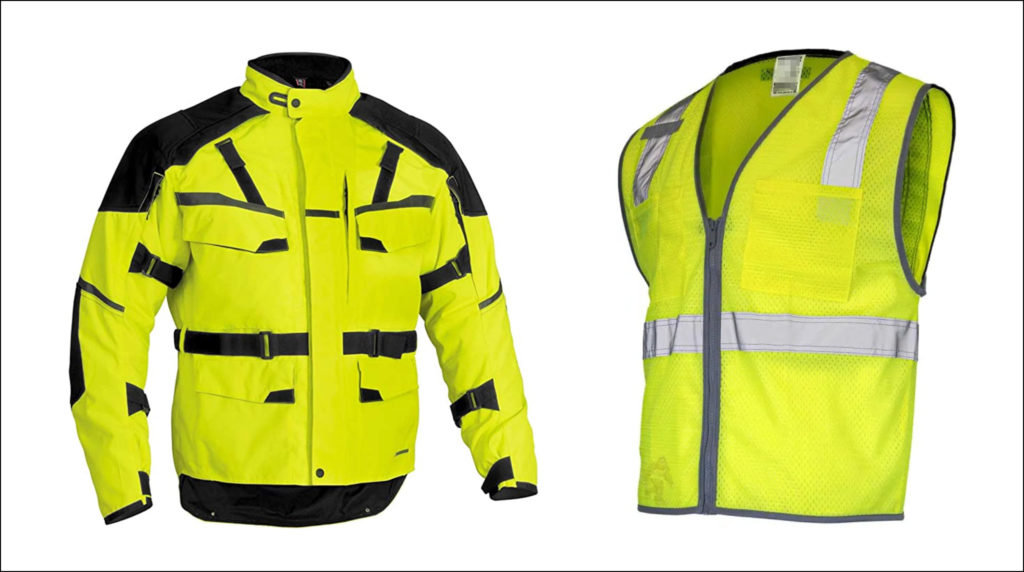
Full jacket and vest in Hi-Viz colors
You won’t get any judgement from me. I’m one of those guys. I’ve been wearing black leather for nearly 40 years and I’m not likely to change. I’m an ATGATT (All The Gear, All The Time) guy. I haven’t always been; and I’m grateful that I survived a lot of early years and foolish miles without wearing appropriate protective riding gear. But my gear is still black. My armored BMW Motorrad leather jacket does have some reflective panels on it. My hot weather Alpinestars textile riding suit has red and white accents sharing its mainly black construction. I wear a flat black helmet. I’d be lying to you if I told you my choices weren’t somewhat fashion-driven.
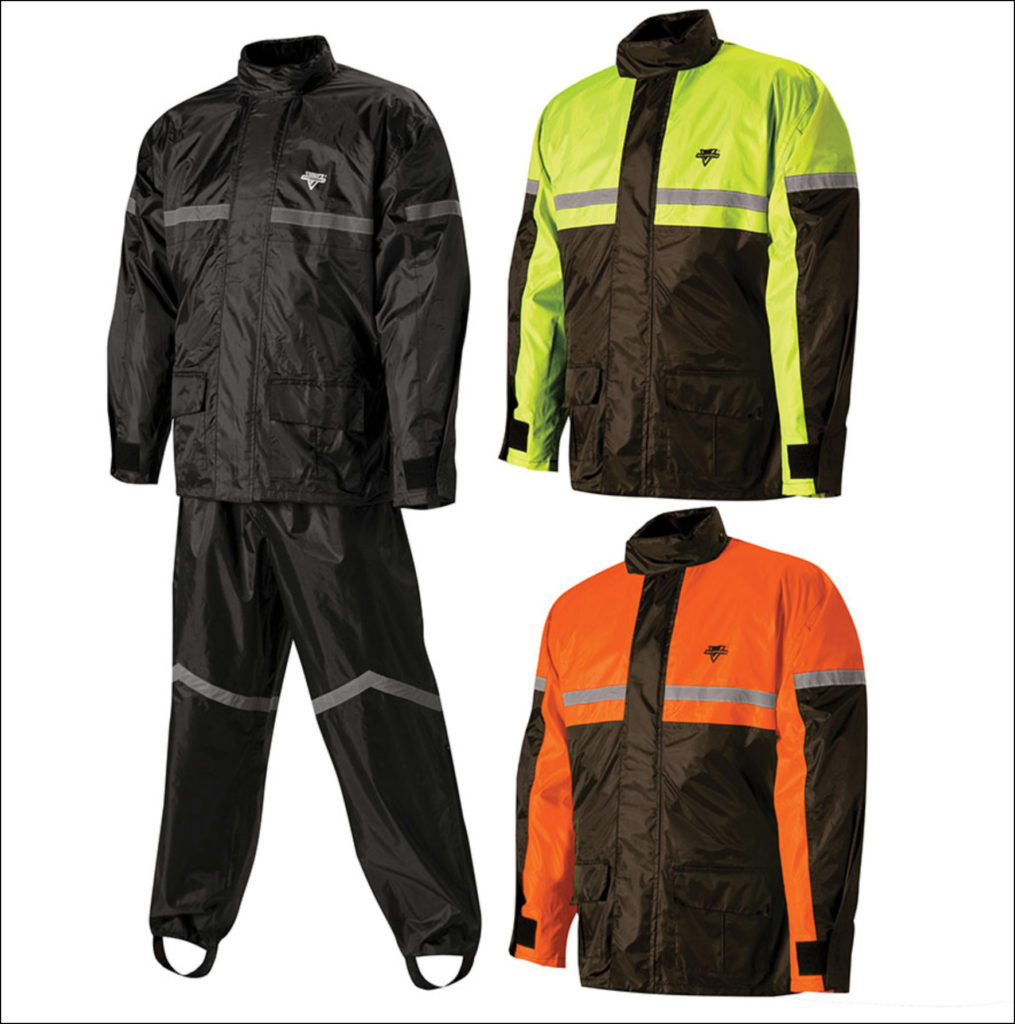
Visibility becomes even more important when the weather turns sour
If you’re the type that doesn’t mind wearing a bright orange vest or a hot pink helmet then, by all means, go for it. I’m just not that guy. In my defense I will tell you that my foul weather rain gear is constructed of high visibility fabric. I do want to give myself that extra measure of safety when visibility deteriorates in inclement weather. There are other ways to stand out on the road. Let’s discuss a couple of them now.
Let Your Light Shine
One of the best things you can do to enhance motorcycle safety and survival is to add effective auxiliary lighting to the front of your machine. I’m not talking about that tacky neon lighting that draws the attention of the local disco queen when you’re parked at the club on bike night. I’m talking about serious auxiliary lighting that helps you to be seen by the generally inattentive folks you’re sharing the roads with.
I can tell you from personal observation that some well-placed auxiliary lighting on the front of your motorcycle is the best way to get noticed by inattentive drivers. Whether the bike is coming at me or if it is coming up behind me in my mirrors makes no difference. It catches my eye. It stands out! People see you coming.
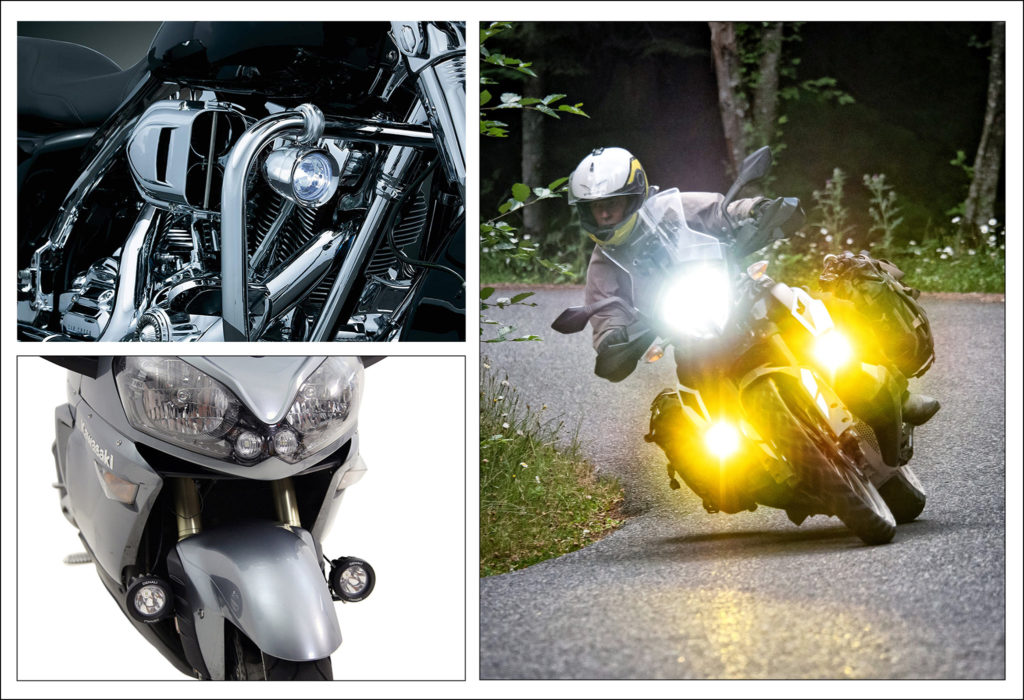
Auxiliary lighting solutions are available for all styles of motorcycles
There are top-of-the-line auxiliary lighting solutions offered by such reputable companies as Denali and Clearwater. Even the inexpensive knockoffs you’ll find on eBay and Amazon will get you noticed. Nothing beats auxiliary forward lighting for adding to a motorcycle’s visibility.
These auxiliary light setups got their start in the ADV bike segment. All motorcycles can benefit from additional forward lighting and this safety trend has established itself on all types of bikes. Stylish and effective offerings are available for ADV bikes, cruisers, sport bikes and large touring machines.
Watch Your Rear
There are innovative lighting products available that protect your hindquarters also. According to the NHTSA 14% of all motorcycle accidents are rear end collisions. This, again, speaks to the point that visibility is a key issue for bikers. When you come to a stop you would like to know that the vehicle behind you is doing the same.
Most recently-produced bikes are equipped with high intensity LED brake lights. Older models tend to be equipped with the less effective halogen bulbs. Whatever type your bike is equipped with it can benefit from the addition of some aftermarket solutions.
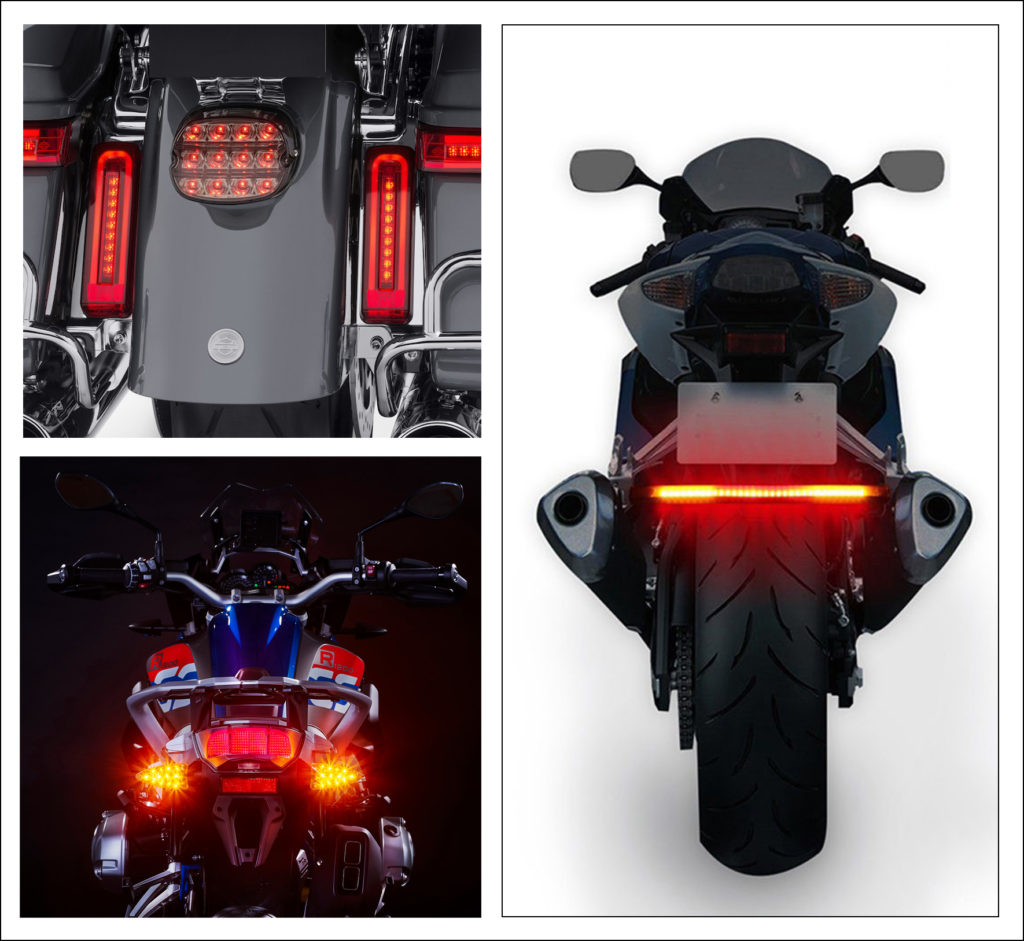
The choices range from the simple installation of additional running lights and brake lights to some more exotic solutions. I am a big proponent of the rear lights that flash when the motorcycle operator applies the brakes. There is no denying that these lights, when activated, attract the attention of the driver behind you. Check your local laws before installing and programming these flashing brake lights. In California, for example, the law states that these lights can flash no more than four times in four seconds before reverting to the normal fully-illuminated state.
Another recent trend I’ve seen is that of riders installing flashing brake lights on the back of their helmets. These are self-contained, rechargeable units that don’t tie in to the bike’s electrical system. They are activated by an accelerometer and do their flashy act when the bike slows down. I’m still undecided about these. There’s no doubt that they will draw some attention from the driver behind you…always a good thing.
However I was recently part of a group ride where one of the participants used one of these devices. In a group motorcycling environment the constant activation of the flashing light became a terrible distraction that upset the pace and rhythm of all the other riders in the group. At the first rest stop he was politely asked to turn the damn thing off. Probably best to consider using one of these devices exclusively on solo rides.
The Great Escape
There are a couple of things every rider needs to be doing when they come to a stop in traffic. These are motorcycle safety and survival practices not to be ignored. First, and foremost, leave your bike in gear…in first gear…until you are absolutely certain that no threats from the rear exist. Far too many motorcyclists shift their bikes into neutral as they roll to a stop. The riders of certain brands will tell you that they “have” to do this. If they don’t they have a hard time “finding neutral” when the bike is at a standstill.
Deal with it. Your physical well being is far more important than a little gear shift inconvenience. Until traffic is safely stopped behind you, and you’re sure that you’re not in danger of being rear-ended, you need to be ready to move out of harm’s way in an instant. You can’t do that if your bike is in neutral.
As you come to a stop (especially when you do so behind another vehicle) assume a position in the left or right track of the traffic lane. Leave enough room in front of you to pull out of the lane and get around the car in front of you if you see danger in your rear view mirror. You are looking in your mirrors when you come to a stop, aren’t you?
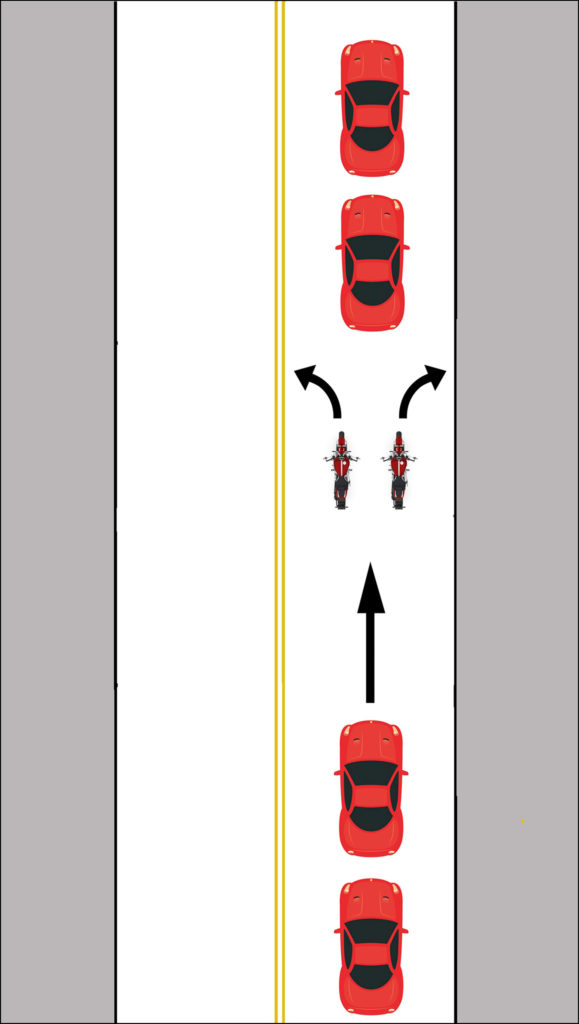
Motorcycle in first gear, to either side of the center track, ready to escape from a dangerous situation
I once startled a passenger on my bike by hastily bolting towards the shoulder of the road after we had come to a full stop in traffic. Before she had a chance to ask me what I was doing, the car that had been following us crashed violently into the unsuspecting car in front of us! You only need to experience this once and you’ll never again slip your bike into neutral until it’s absolutely safe to do so.
Do Loud Pipes Save Lives?
I don’t want to start a great debate on this topic, but it does deserve being mentioned. Before I offer my opinion I will tell you that I have been on both sides of the argument. I spent 25 years behind the bars of big-inch American V-Twin motorcycles; a couple of which had serious high performance engine work done, along with the requisite open exhaust systems. Today I ride a European sport touring machine that purrs like a brand new sewing machine.
My “loud pipes bikes” included a Springer Softail® with upswept fishtails. A custom Dyna® with V&H Short Shots®. A Sportster® that made 100HP at the rear wheel (also with Short Shots®). A Vengeance Vertebreaker® hard tail chopper with a big inch S&S motor and straight pipes. Heck…even my last ElectraGlide® had head work, cams, re-mapped fuel injection and a de-catted true dual exhaust system. I understand the whole “loud pipes” thing. But let’s be honest here. It has everything to do with image and nothing to do with our safety concerns.

Some of the author’s previous “Loud Pipes” bikes
Our adversaries on the road are more distracted today than at any time in history. People are tightly sealed off in their well-insulated, climate-controlled cars; multitasking behind the wheel in alarming ways. Talking on cell phones. Texting. Sipping their lattes and frappucinos. Listening to voice commands from onboard navigation devices. Scrolling through their social media feeds. Listening to their favorite podcast. Watching videos! You invent a new distraction and some idiot is sure to become a player. By the time these clowns hear…and maybe respond to…the sound of your loud pipes, it’s already too late.
Twenty years ago I wouldn’t have said that. In fact I was known to use a twist of the throttle in lieu of my horn back in the day. It worked back then. Today? Not so much. All the other distractions have become too strong and too numerous these days to be combatted with a few extra decibels. About the only thing loud pipes are good for these days are to voice your displeasure with an offending, inattentive driver if you’re lucky enough to wind up next to them at the next red light. Other than that, they’re just more noise in an already oversaturated environment full of distractions.
By the way…any of that righteous sound that might be heard, is heard by folks located behind the bike. Some US states have not only enacted more stringent exhaust noise regulations; but have backed them up with the installation of noise detection systems alongside the already-installed red light and speed monitoring cameras. Guess when these systems detect the offensive exhaust notes? You got it! After you’ve passed the monitoring device. They don’t hear you coming.
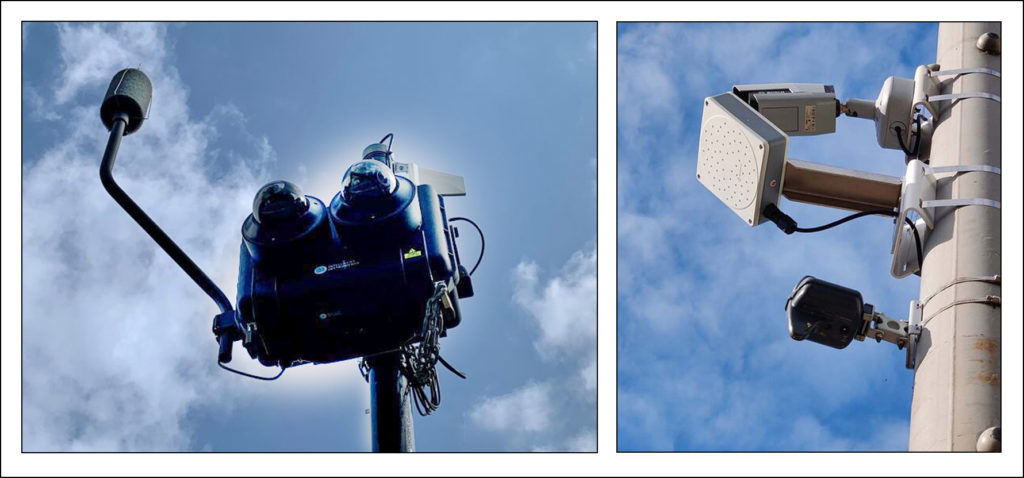
Excessive noise detection devices are showing up in the US. Good idea or just another municipal revenue stream?
If you’re approaching an intersection and oncoming traffic is a hundred yards away, they don’t even know that they are sharing the road with you and your open exhaust. Pay attention to what YOU’RE doing. You can be pretty sure they’ve tuned out everything else around them.
If you’re forced to execute an emergency maneuver you want to have full control of your machine. Don’t handicap yourself by having the clutch pulled in and the throttle open to make noise. That loud exhaust blast you just barked out will do nothing to help you perform a controlled emergency accident avoidance maneuver.
You don’t have to take my word for this. Quite a few studies have been done on the topic by government agencies and independent laboratories. Here are a few links to reputable sources that have published the results of these studies:
When I was a little kid my parents kept my sister and I occupied on long family road trips by having us be on the lookout for Volkswagen Beetles on the highway. We would delight in being the first to spot a ‘Bug’ that was sharing the road with us.
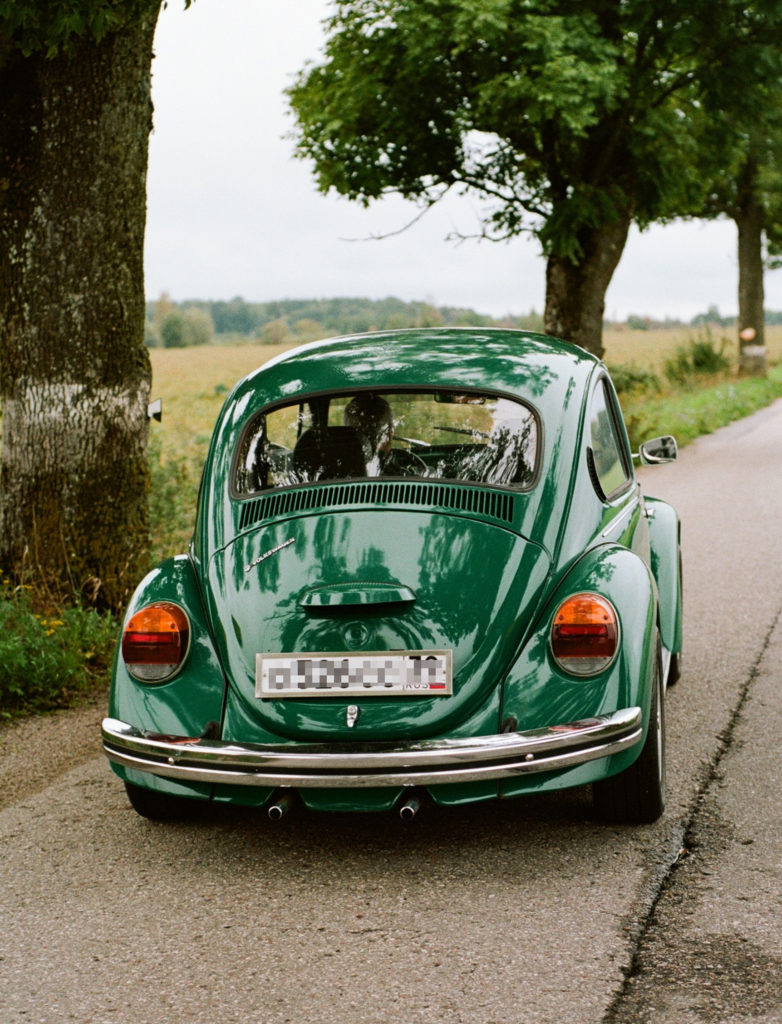
Very few of these are left on the highway. Teach your kids to look for motorcycles instead.
Want to do something really great for the next generations of bikers? Make a game out of having your kids look for motorcycles on the road. By the time they’re old enough to get behind the wheel they’ll be conditioned to look out for motorcycles! Great concept. Share this idea with everyone you know.
Motorcycle Safety And Survival • Conclusion
That about wraps it up for this post on motorcycle safety and survival. In the next installment we’ll be discussing some hazards and booby traps you’ll encounter on the road. Maybe some you’re already aware of. Probably some you never even considered. Either way, we’ll be providing some great tips and techniques to keep you from becoming a sad statistic. Be sure to subscribe to Roadcraft USA for notifications when future posts are published. As always we welcome your comments below.
Click Here to view an interactive visual index page where you can quickly browse through all of the great features that are published on the Roadcraft USA blog.

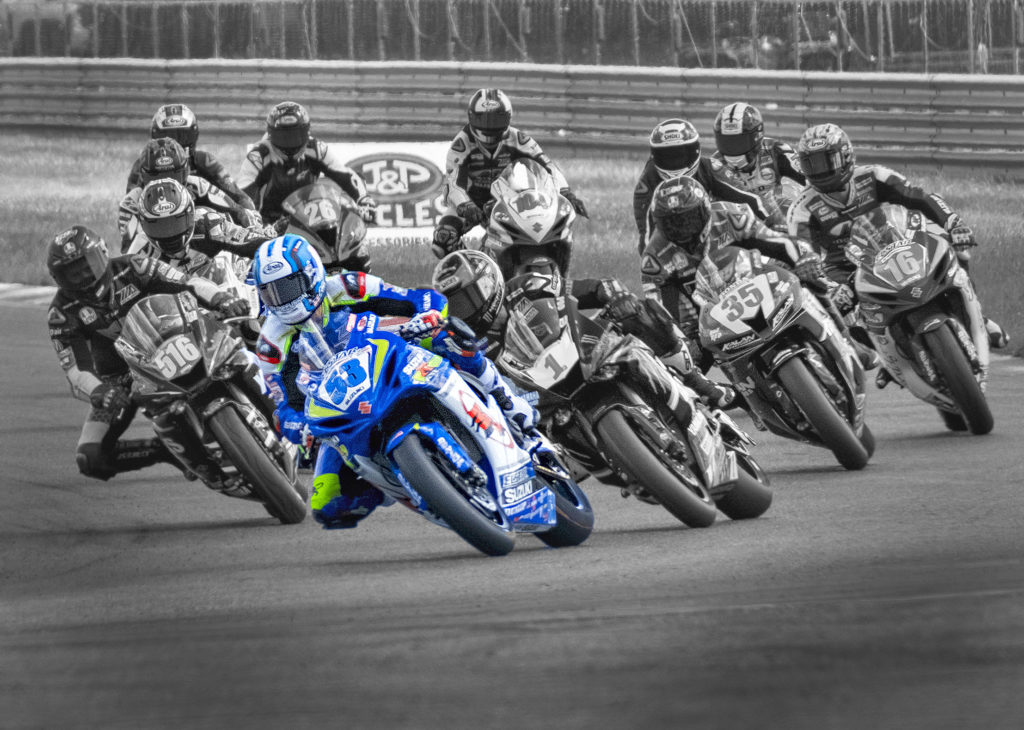
Thank you for your thoughtful insights and review of core safety considerations. I’ve come to think the bumper sticker campaign “Start Seeing Motorcycles” would be better directed toward “Let’s Make Motorcycles Be Seen”. In addition to recommending hi-vis riding gear/helmets and auxiliary lights, I would add modulating headlights to that list. Federal law permits motorcycles nation wide to be the only civilian vehicles to operate with modulating headlights.
FMVSS 108(Federal Motor Vehicle Safety Standards) (49 CFR Part 571.108 S7.9.4) allows motorcycle headlight modulation systems all 50 states provided they comply with the standards set forth in this section.
My pleasure, Paul Thanks for sharing the information on modulating headlights. I was not aware of that law. The article did mention California’s restriction on modulating brake lights…limiting them to four flashes before they are required to be in a full “On” state. Thanks for reading and sharing!